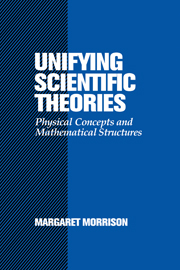Book contents
- Frontmatter
- Contents
- Acknowledgements
- Introduction
- 1 The Many Faces of Unity
- 2 Unification, Realism and Inference
- 3 Maxwell's Unification of Electromagnetism and Optics
- 4 Gauges, Symmetries and Forces: The Electroweak Unification
- 5 Special Relativity and the Unity of Physics
- 6 Darwin and Natural Selection: Unification versus Explanation
- 7 Structural Unity and the Biological Synthesis
- Conclusions
- Notes
- References
- Index
3 - Maxwell's Unification of Electromagnetism and Optics
Published online by Cambridge University Press: 06 October 2009
- Frontmatter
- Contents
- Acknowledgements
- Introduction
- 1 The Many Faces of Unity
- 2 Unification, Realism and Inference
- 3 Maxwell's Unification of Electromagnetism and Optics
- 4 Gauges, Symmetries and Forces: The Electroweak Unification
- 5 Special Relativity and the Unity of Physics
- 6 Darwin and Natural Selection: Unification versus Explanation
- 7 Structural Unity and the Biological Synthesis
- Conclusions
- Notes
- References
- Index
Summary
Maxwell's electrodynamics undoubtedly represents one of the most successful unifications in the history of science. Its demonstration that optical and electromagnetic waves travel with the same velocity and that both phenomena obey the same laws is paradigmatic of what we call the unifying power of theory. Despite enjoying some early success in Britain, there was a 15-year gap after publication of the Treatise on Electricity and Magnetism (Maxwell 1873) before Maxwell's theory was accepted on the Continent, fully supplanting action-at-a-distance accounts as the received view of electrodynamics. But even among Maxwell's British contemporaries there was by no means open enthusiasm. Sir William Thomson (Lord Kelvin) was highly critical of Maxwell's theory, despite being himself a proponent of field theoretic views of electromagnetism.
The history of the development and acceptance of Maxwell's electrodynamics is interesting from the point of view of theory unification for several reasons. First, the rather striking unification of electromagnetism and optics seems to have provided little reason to embrace the theory; even its advocates (including Maxwell himself) did not mention unifying power as playing an evidential role. To that extent the case provides a counterexample to the popular philosophical argument that unification functions to increase the likelihood that the theory is true or that it even functions as a criterion for theory choice among competing rivals. Second, the theory's development took place in several stages, the first of which depended on a mechanical aether model that was given up in later formulations.
- Type
- Chapter
- Information
- Unifying Scientific TheoriesPhysical Concepts and Mathematical Structures, pp. 62 - 108Publisher: Cambridge University PressPrint publication year: 2000

